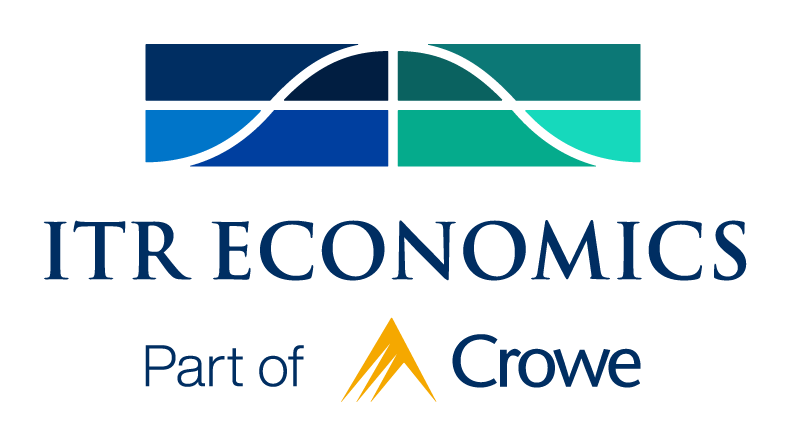July 8, 2024
- Home
- portfolio
- TrendsTalk
- July 8, 2024
ECONOMIC GROWTH AND THE 2030S DOWNTURN WITH SPECIAL GUEST JENN DESROSIERS
This week on TrendsTalk, we are joined by Strategex Managing Director Jenn Desrosiers to discuss how we can help businesses both make the most of the coming economic growth and prepare for the downturn expected in the 2030s.

MEET YOUR HOST
Taylor St. Germain
As an experienced economist, Taylor St. Germain provides consulting services for small businesses, trade associations, and Fortune 500 companies across a spectrum of industries. His dynamic personality and extensive knowledge of economic trends and their business relevance are highly valued by clients and colleagues alike.
“Join me on the TrendsTalk podcast to explore the world of economics. Episodes offer insightful discussion and expert interviews. We cover relevant economic concepts in an accessible way. Whether you are a curious layperson or an industry professional, TrendsTalk is your go-to source for thought-provoking analysis and a deeper understanding of the economic forces shaping our world.”
Key Episode Takeaways
- 0:33 – Strategex Managing Director Jenn Desrosiers joins us on TrendsTalk this week
- 6:54 – Advice on preparing for economic growth in 2025 and 2026
- 13:33 – Discussing the challenges coming with the 2030s depression and having contingency plans
- 19:34 – The value of Strategex’s internal data analysis and ITR Economics’ methodology and insights
The below transcript is a literal translation of the podcast audio that has been machine generated by Notta.
Taylor St Germain:
Hi, everyone. Thanks so much for joining us on this episode of TrendsTalk. I’m your host, Taylor St. Germain, with ITR Economics. We at ITR Economics are your apolitical and unbiased source of economic intelligence.
And today we have a very special guest with us. We have Jenn Desrosiers from Strategex. She’s the Managing Director of Strategex. Thanks for joining us, Jen. We appreciate it.
Jenn Desrosiers:
Thank you so much for having me, Taylor.
Taylor St Germain:
Could you share with us a bit of an overview of Strategex, your experience, the company’s experience, and how you all help businesses?
Jenn Desrosiers:
Absolutely. So, Strategex is a management consulting company headquartered in Chicago. We are a team of veteran business leaders, data analysts, researchers that are really all united in using data to help transform our clients’ businesses and ultimately achieve outsized, very profitable market share growth.
So, the Strategex is made up of kind of three sub businesses and I work in the profit enhancement and growth strategies business, affectionately referred to in the market as the 80/20 business. And that is because the majority of the team are former manufacturing business leaders that really operated with an 80/20 philosophy and that we understand very few things matter disproportionately to the results, and therefore we should give them all the time attention resources that they deserve. So, we work with clients to integrate some of that thinking and achieve just outsized growth in their markets.
Taylor St Germain:
And I know that resonates with ITR, and it’s one of the reasons we love you guys so much because of that data-driven approach that you take there. Could you give us a little bit more of your background?
Jenn Desrosiers:
Absolutely. So I started the first decade of my career in industry, a large manufacturing conglomerate that at the time was about 850 decentralized business units, $18 billion. And so we knew a thing or two about operating very close to our customers and close to our niches.
And I worked there about a decade background, chemical engineering moved into strategy, commercial management, and then ultimately ran some of the operations for for that company, they operate with an 80/20 mindset.
So, so ultimately, I had the opportunity to leave that company and join Strategex, who is a team of like minded business leaders that, you know, we’re so lucky, it’s the best job in the world, because we get to teach other people how to frankly, do less, it make make more money, have more fun, and ultimately have more time, all with less stress.
And so it’s, it’s fun, not only to see businesses transform and achieve the results that they do in the market, but also, you know, we see people’s lives change and evolve. So it’s very rewarding.
Taylor St Germain:
We always hear time is the biggest commodity, right? And it’s always the way we’re trying to get back. And I think what you all do really fits with the theme of what we’ve been discussing, which is efficiency investments.
As we look forward to this future, it’s all about how can we make what we have existing more efficient to take on more and give us some time back. So I think that’s really going to resonate with a lot of our listeners as well, as that’s been one of our primary focus with all of our clients as well.
And speaking of how our clients are feeling, I guess that’s where I wanted to start some of the questioning right now. We felt a little bit of weakness in 2024, especially the first half of the year, but I wanted to get some perspective on how your clients are feeling so far in 2024.
Jenn Desrosiers:
Absolutely. The first half of the year has been really flat, really soft. There’s been a fair amount of headwind and a flat to weak market. So that is true. And then when you look at organic growth numbers, they are low and minimal at best. Some sectors are experiencing a little more contraction, actual decline, maybe some of the, my machinery clients and others more computer driven, or we’re seeing a little growth there, maybe because government spending and, but overall relatively, relatively weak.
And yet the business leaders are optimistic. They’re, they’re excited about the next forecast and what ITR is talking about for 25 and beyond. And so they’re looking at how do I invest effectively now to make sure I have the capacity needed for that future forecast.
Taylor St Germain:
We’ve been talking so much about this industrial production weakness, manufacturing weakness like you’re alluding to. And we’re sort of approaching that low point, right? And so low point in quotes, because yes, it’s not ‘08 ‘09. It’s not the COVID timeframes, but most companies are slightly down year over year. Most vertical markets are feeling some of that just sluggish activity. I’m going to sound like a broken record for our listeners, but I keep saying I’m not worried about us surviving ‘24. I’m worried we’re not prepared to take on this growth in ‘25 and ‘26. And it sounds like you’re thinking similarly there.
So, when you’re talking with your clients about ‘25, what are some things you’re focused on? What’s some of the pieces of advice you’re sharing with them?
Jenn Desrosiers:
Absolutely. We couldn’t agree more with you. We are not in crisis mode. That’s a slight decline at worst, and it’s an amazing time for us to prepare for the growth that’s coming.
So, I’ll use an analogy. When we’re fit and healthy as human beings, if we get sick, we recover a lot faster. And so it always makes sense that when things are calm, even when things are going well, get your ducks in order, get your business healthy and fit to play out the analogy, because eventually when the next downturn comes, we’ll be better positioned to recover from that.
So, what we’re working with today with our clients in 2024, it is really a little bit of that 80/20 philosophy. So what are the 20% of few things that drive 80% of your revenue that you should understand very well and get organized around today?
I’m telling my clients, you know, I guess three pieces of advice. One, get your data, pull your data. We think we know our businesses, and yet we should always be diligent to pull the actual business data and double check what we think we know.
So, one piece of advice I could give listeners today, simple analysis, we like to do the quartile analysis. You can do this in under 30 minutes for your business, and I recommend you do. Start with your customers. Take an extract of all of your customers that you have transacted with over the last 12 months, and take their full year revenue as well. Sort that list in descending order. So at the top, you have customer number one. They are your largest customer in revenue. And at the very bottom, at the very long tail, you’re gonna have a tiny customer who may have actually placed an order with you for less than a dollar. I see this in spare parts businesses. You wouldn’t believe it.
So, pull them high to low, and then break them into groups of 25% by customer count. For the sake of easy math, say you have 100 customers, your top quartile then would be customers number one to 25. Your second quartile would be customers 26 to 50, and so on. And what you’ll find is that that top quartile, so the top 25% of your customers are gonna be about 89% of your revenue. The next quartile, 7%.
So, what remains is 50% of our customers that only contribute 4% or less of our revenue. And part of getting your data is to then understand if I assign my resources and overhead to these groups of customers, what does it look like? And what we’ll find is it’s relatively evenly spread. So your top quartile, that’s 89% of your revenue really only takes up about 25% of your overhead or resources. So again, if we look at that bottom half, that long tail, we have 50% of our customers, 4% of our revenue, and 50% of our overhead. So, we are absolutely operating at a massive loss in this long tail of customers.
And on the flip side, we make more than 150% of our profit on that top quartile. And then we systematically give it away by choosing to transact the way we do today. And so, all I’m saying is get the data, understand those top customers, you can do the exact same quartile analysis for your products if you want, it’s gonna show a similar result. Top customers, top products, and understand your top people. 80/20 applies to your talent too. 20% of your team does 80% of the work. And so we need to know that, reward them differently, treat them better. So get the data. We like to say, get the facts, let the facts tell you what to do.
So that leads me to my second piece of advice. Segment your business differently based on what you learn from your data. Have segments that are focused around your large, most profitable customers. Assign your top talent to those segments to nurture those relationships, grow with those customers, and go win similarly sized large customers that you don’t have today. So, focus there.
And then the third piece of advice is now simplify everything else. When I say we’re operating at a loss with 50% of our customers today, I’m not suggesting you cut those customers, but you need to simplify the way you work with them. You can change the terms. You can change your business promises to them to make them profitable. And so simplify today as a means to optimize your product or your profit, excuse me. Not maximize your profit, optimize your profit. Remove the complexity and the cost associated with that and then redirect and reinvest some of that cost into growing with your largest, biggest, best customers.
I will tell you what hangs up a client of mine from implementing some of these changes. Compensation structure can be a real deterrent. If I am compensated on every top line dollar is a good dollar, I will take every order no matter the size, whatever the customer, because that’s what I’m incentivized to do. So, let’s make sure that our compensation programs and incentive structures align with driving profitable behavior.
But once we’ve done that, we, you know, we’ve gotten our data, we’ve segmented the business, we’ve simplified everything else. Now you’ve positioned your business to not just enjoy the growth in ‘25 and ‘26, but you will achieve growth 10 times what the market rate of growth will be, because you’ll be organized around over serving your biggest and best opportunities.
Taylor St Germain:
And there’s so much that resonates with, you know, we say like during 2024, lose the losers. And maybe we’re a little blunt on that end, but- I love that. I think it’s, you know, when we boil down to some of the information you were sharing, that’s exactly it, which is, hey, we’re all running into profitability challenges in 2024.
So even though this data exercise you’re mentioning starts with top line numbers, you very quickly see how it goes into the profitability challenges, right? And it’s about allocating resources to where we can maximize some of that profitability. I think it’s important anytime to be doing that, but especially as you’re highlighting when we’re at a low point in the cycle and preparing for all this growth that’s coming our way.
Now we’ve been talking ‘24, ‘25. I know you’re aware of ITR’s 2030 expectation as all of our listeners are. When you’re thinking about the 2030s, when you think about ITR’s 2030 expectations, maybe what are some of the things you talk about with some of the advice or some of the ways you interpret how we navigate through these coming years before the 2030s are upon us.
Jenn Desrosiers:
At one point, Warren Buffett was asked a similar question and it was really tied to inflation. But again, an economic headwind. And he said, the best way for us to protect ourselves is to invest in ourselves. Something to the effect of, if you’re the best lawyer, if you’re the best surgeon, if you’re the best teacher, you will get to share in your portion of the national economic pie. That’s the best way.
And then he quickly followed it with and the second best is a wonderful business. The second best protection is a wonderful business. And that highly aligns with our viewpoint. And so we’re at a downturn now, you and I just discussed some things businesses can be doing to improve for the growth.
And then we’re going to experience something potentially massive in 2030. And so during that period of growth, my encouragement is hold the line on accepting good business. So, companies that are diligent in their practice of 80/20 do well during inflation, they do well during recession, and they do well during depression. And it’s because they have become nimble. They’ve eliminated complexity and the cost that goes with it. They’ve already segmented and optimized their business for profit. When the economy turns up, they’re very agile, they can put and invest resources right at the point of the spear to grow. And when something like 2030 occurs, they have already optimized.
And so, while competitors are making tough decisions that are in some ways crippling and worried on dramatic, drastic cost efforts, not only will your business already be healthy, you will frankly be able to steal some of the large opportunities from your competitors because they’re going to be worried inwardly about survival and lose their ability to serve and over serve their top customers. So, as you prepare, you know, here, we’re going to have this boom of growth. Don’t accept every order. Don’t accept every top line dollar have defined for your business what is profitable and make sure you accept it on your terms.
A recession is always coming, I guess is the an expression, so plan for one, and especially in terms of 2030, write down a couple plans. What does my business look like? What do I have to do if I’m down 5% top line? Second, what do I have to do if I’m down 10 %? Third, what do I have to do if I’m down 20% and some of the dramatic outcomes that may come from that kind of depression and and have it truly spelled out in a plan for the levers you would need to pull when that occurs and structure your business as you’re growing. Structure your business in a way that enables you to have that backup plan when and if it occurs.
Some things to do about that limit the amount of fixed costs in the business, move as much to variable as possible. If you have more than half of your costs are variable, you know, say 75% that’d be great, you’re going to be fine. But if you are strung with a ton of fixed costs is going to be hard if there’s a dramatic downturn. In particular, we talk about outsourcing and vertical integration, have less vertical integration. Typically speaking, it, you know, if your customer pays you for highly engineered smart designed product, they don’t care if you fabricated in house. So partner with a fabrication supplier. So, you’re not stuck with all the fixed costs of a fab shop on your P &L that’s that you can’t do anything with when you have an empty shop and a downturn.
Taylor St Germain:
Yeah, and diversification, right? That’s exactly what we’ve been, that’s what we get reached out to all the time. It’s with 2030 coming, do I look to outsource this? Do I look to get involved in this market? And so a lot of our clients heads are already going to that. How do we diversify, not just markets, but operations, which I think you’re alluding to here, right? Which is exactly the ways we need to be thinking about it.
And I don’t mean to, I guess, oversimplify, but it’s victory loves preparation, right? And that’s what we keep telling all of our clients out there. And like you’ve mentioned here, if we take these next five years to run through these exercises, to be optimizing our overhead based on our profitability, and which clients are really bringing in what top line numbers through the door, I think we’re going to find ourselves in a very nimble and agile position for 2030.
And the 2030s, these recessions and depressions are what breed millionaires and billionaires. It’s all about taking those steps to be prepared. So for all of our listeners out there, if you’re listening to this advice from Jen, you’re going to find yourself in a situation in the 2030s where not only are you prepared through the different scenarios that you’re planning for, but if you take these steps to repair, you’re going to be buying businesses at half the cost. You’re going to be hiring people at lower rates. You’re going to be taking advantage of all of this economic opportunity that’s out there.
And so we appreciate that specific advice because we live in the macroeconomic world in this top line world. And it’s really great to have someone like Strategex come in and boil down into some of the nitty gritty that our clients need in terms of understanding, some examples of how to take on these next few years.
I wanted to linger on our relationship together and just get some perspective on maybe how ITR’s methodology has helped out some of Strategex clients.
Jenn Desrosiers:
Oh, absolutely. We have a host of stories. I said earlier that Strategex likes to say, get the facts that the facts tell you what to do. And we certainly do that with our clients through looking at their internal data. But the beautiful compliment of ITRs methodology is it gets the facts, and it gets them straight on the market dynamics. So the custom indices that can be built to be leading indicators for our clients, enable insights, and again, more agility through data empowered decisions.
So, one example, um, you know, we have a client who is experiencing an upward trend in their, you know, three-month average, three month moving average and 12 month rate of change. And yet the business results weren’t quite reflecting what the ITR kind of leading indicator report would have suggested. And so they were able to very quickly investigate that and understand systemically what was wrong in the business. So they didn’t just six months later realize I missed a whole market movement. And they were able to you know, redeploy resources to fix a systemic business issue to to get back to where they need it to be. So the two compliment very well.
Taylor St Germain:
Yeah, and that’s that’s it. That’s the plug. I don’t and geez, and we should just end right there. That’s great. Folks, track your rates of change, track them against leading indicators. It’s really important for us to understand not just the overall trend in our business, but the pace at which this growth or contractions occurring, and how your data correlates to the economy.
So that again, you are understanding how the economy is moving in relationship to your business. And you can make those some of these strategic decisions we’re talking about, based off that. So we appreciate that very much that that it our example, Jen, where can our listeners learn more about you and more about strategics?
Jenn Desrosiers:
So, we have a plethora of resources on our website, strategex.com. It’s S -T -R -A -T -E -G -E -X .com. You’ll find my contact information there. Personally, if you’d like to reach out, please do. If you feel so inclined to run your quartiles and wanna talk to me about them, I’d love to do that. Self-admitted data geek, so please, by all means reach out, I’d love to talk to you about it.
And Taylor, another plug I’ll make is Lauren Saidel-Baker from ITR Economics and I are co -hosting a webinar with the Manufacturers Alliance investigating this topic further and talking specifically about details around the ITR forecast and more details around what kind of tactics Strategex would recommend. And so that’ll be on July 23rd. I recommend listeners tune into that as well if they want some more information.
Taylor St Germain:
That’s great. And I know our team will include some of these links here in our show notes. And just a reminder to everyone who’s listening in here today, please like and subscribe to TrendsTalk wherever you listen to your podcast.
Look out for Jen and the Strategex team in that upcoming webinar. And Jen, we just want to thank you so much for being here today. I know ITR values our relationship with strategics closely. So appreciate your time and thanks for joining us.
Jenn Desrosiers:
Thank you so much for having us. Thank you, Taylor.






